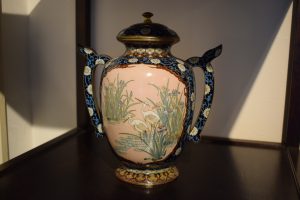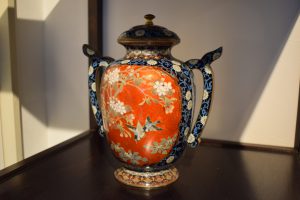七宝の歴史(愛知県名古屋市千種区姫池通 骨董買取いたします 古美術風光舎名古屋店)
2022.04.29
皆さま、こんにちは。スタッフMです。
4月ももうすぐ終わり、若葉が輝く5月を迎えようとしているそんな今朝、家を出ると「ホーホケキョ」と聞き覚えのある声が聞こえてきました。
あれ?聞き間違いかな?とも思ったのですが、その後も2回程鳴いていたのです。本来、2月下旬から3月くらいにかけて鳴くイメージがあったので少し驚きましたが、とても上手に鳴いていて少しほっこりとする1日のスタートでした。
そんな今日は、久しぶりにスタッフMの古美術学習の日として、ご紹介したい作品がございます。
今回はこちらの「七宝焼」でございます。


こちらの壺は明治期に作られた七宝焼・飾り壺で、季節の違う二面の構図が焼かれた物です。
左右の草花と鳥の優しい絵柄ですが、どこか力強さもあるような魅力的な作品です。
「七宝焼」について少し説明させていただきますと、「七宝焼」とは、金属の表面に色とりどりのガラス質の釉薬(ゆうやく)をのせて焼き付けたものです。
ヨーロッパからシルクロードを通り、中国を経て日本に伝わったと言われており、紀元前から古代メソポタミア文明や、古代エジプト文明にこの七宝焼に似たものを見つけることができます。
なぜこういった焼き物が「七宝」と呼ばれるのか、ご存知ですか?
この「七宝」とは仏教の経典にある七種類の宝を散りばめた様に美しいものという意味で名づけられたそうです。
日本の最古の七宝は古墳から出土したもので、7世紀頃に作られたとされるものです。
その後は、寺院や城の建具の一部に七宝が作られることもしばしば。
そんな親しみのある七宝ですが、日本ではあまり作られていませんでした。
その七宝が広く作られるきっかけとなったのは、名古屋市に住んでいた「梶 常吉(かじ つねきち)」という人物が1833年に自ら研究し、作り方を発見したことから始まります。
その後、梶 常吉の功績により、急速に七宝の製造が広まり、愛知県尾張地方は日本の七宝製造の中心地となります。
様々な工夫が加えられ、尾張七宝は作られ続けてきましたが、第二次世界大戦では生産が中断されてしまいます。
これにより、現在では失われてしまった技術もありますが、日本を代表とする伝統的な工芸品として、1995年経済産業省指定の伝統的工芸品となっているそうです。
この七宝焼をより身近に鑑賞することのできる施設が愛知県・あま市の「七宝焼アートヴィレッジ」。
こちらでは作品鑑賞はもちろん、製作工程の見学や制作体験等もでき、七宝焼についてさまざまな角度から学ぶことができるそうです。
情報によると、この館内もおしゃれですが、敷地が広く緑に囲まれているのでヒーリングもできるそうです。
天気の良い日を狙って、これを機に私も一度学んでみようと思います!
今回のスタッフMの古美術学習はここまで。
また次回も一緒に学びを深めていきましょう~。
Hello everyone. This is Staff M.
April is almost over, and when I leave the house this morning, when the young leaves are shining in May, I heard a familiar voice saying “Hohokekyo”.
that? Is it a mistake? I also thought, but after that it was ringing twice. Originally, I was a little surprised because I had the image of crying from late February to March, but it was a very good crying and a little relaxing start of the day.
Today, I would like to introduce a work that I would like to introduce as Staff M’s antique art learning day for the first time in a long time. This time is this “Shippo-yaki”.
This jar is a cloisonne ware and decorative jar made in the Meiji era, and has a two-sided composition with different seasons. It is a gentle pattern of flowers and birds on the left and right, but it is a charming work that seems to have some strength.
To explain a little about “Shippo-yaki”, “Shippo-yaki” is made by putting colorful glass glaze on the surface of metal and baking it. It is said that it was introduced from Europe through the Silk Road to Japan via China, and you can find something similar to this cloisonne ware in ancient Mesopotamian civilizations and ancient Egyptian civilizations from BC.
Do you know why these pottery are called “cloisonne”? This “cloisonne” is said to have been named in the sense that it is as beautiful as the seven types of treasures in the Buddhist scriptures.
The oldest cloisonne in Japan was excavated from an ancient burial mound and is said to have been made around the 7th century. After that, cloisonne is often made on some of the fittings of temples and castles. Although it is such a familiar cloisonne, it was not made much in Japan. The reason why the cloisonne was widely made began in 1833 when a person named Kajitsunekichi, who lived in Nagoya, researched himself and discovered how to make it. After that, thanks to the achievements of Tsunekichi Kaji, the production of cloisonne spread rapidly, and the Owari region of Aichi prefecture became the center of cloisonne production in Japan.
Various ingenuities have been added, and Owari Cloisonne has continued to be made, but production will be interrupted in World War II. Due to this, some techniques have been lost now, but as a traditional craft representing Japan, it is said to have become a traditional craft designated by the Ministry of Economy, Trade and Industry in 1995.
The facility where you can appreciate this cloisonne ware more closely is “Shippo ware Art Village” in Ama City, Aichi Prefecture. Here, you can not only appreciate the works, but also observe the production process and experience the production, and you can learn about Shippo-yaki from various angles. According to the information, this building is also fashionable, but the site is wide and surrounded by greenery, so you can heal. Aiming for a sunny day, I will take this opportunity to learn once!
This is the end of staff M’s learning of antique art. Let’s deepen our learning together next time.
*********************
新年度を迎えました。
風光舎では、古美術品や骨董品の他にも絵画や宝石、趣味のお品など様々なジャンルのものを買受しております。
お片付けをされていて、こういうものでもいいのかしらと迷われているものでも、どうぞお気軽にご相談下さいませ。
また風光舎は、出張買取も強化しております。
ご近所はもちろん、愛知県内、岐阜県、三重県その他の県へも出張いたします。
まずは、お電話お待ちしております。
愛知県名古屋市千種区・骨董 買取
『古美術 風光舎 名古屋店』
TEL 052(734)8444
10:00-17:00 OPEN

